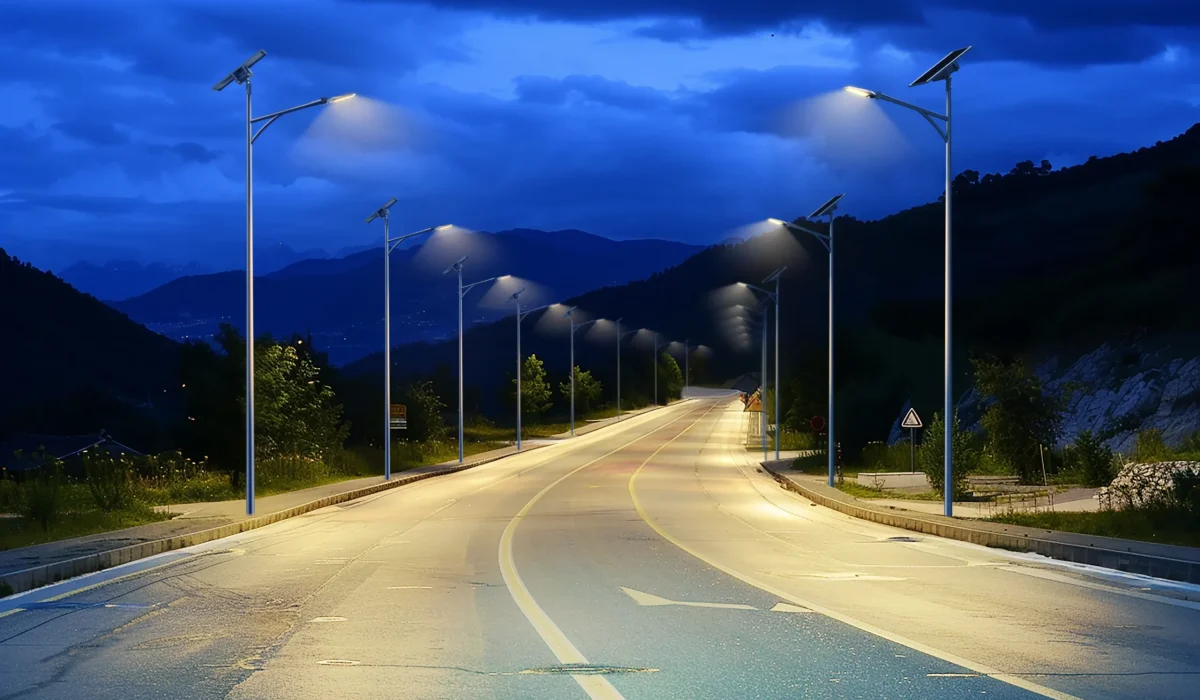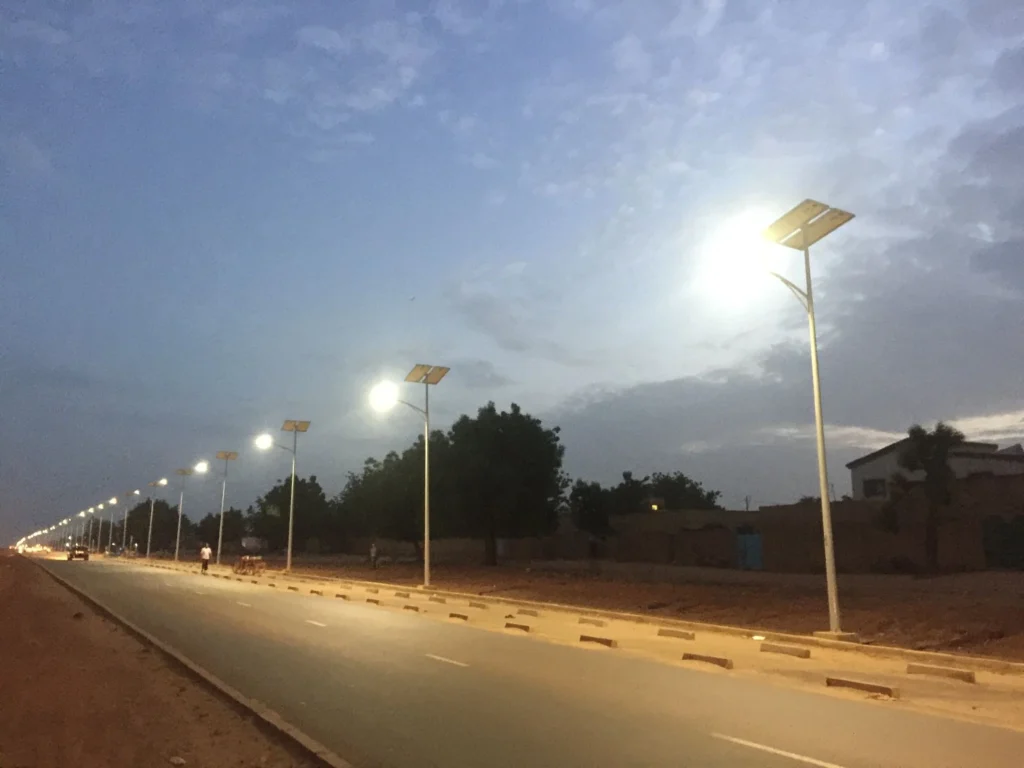Project Year: 2012
Location: Treichville District, Abidjan, Côte d’Ivoire
Units Installed: 890
Product Model: 30W Integrated Solar Street Light
Installation Height: 5 meters
Project Engineer: Mr. Lin
Executing Department: Overseas Engineering Division
Abstract
In 2012, our engineering team installed 890 units of 30W integrated solar street lights along Boulevard de Marseille and surrounding streets in Treichville District, Abidjan. The project was designed to improve visibility, community safety, and urban sustainability through off-grid solar technology.
By combining efficient LED lighting, lithium storage, and intelligent control, the system provides stable illumination independent of the national grid. Since completion, the project has remained fully operational and has become one of the first successfully maintained large-scale solar lighting systems in Côte d’Ivoire.
1. Project Background — From Darkness to Light
Treichville is one of Abidjan’s oldest urban districts, known for its markets, bus terminals, and waterfront neighborhoods. Before 2012, its street lighting infrastructure had been inconsistent due to grid instability and limited maintenance budgets.
Boulevard de Marseille, stretching about 4.3 kilometers, was particularly affected — many streetlights were broken, and average illumination was below 2 lux, making night-time travel unsafe.
Following the country’s post-conflict reconstruction plan, Treichville’s local government initiated a clean energy program to modernize urban infrastructure while reducing energy costs. After an open tender, our company was selected in March 2012 to deliver a turnkey solar street lighting solution covering the entire boulevard and adjacent roads.
The project’s mission was clear: to deliver long-term, grid-independent lighting for Treichville’s main roads — lighting that could operate reliably under local weather and energy conditions.
2. Engineering Design and Technical Solutions
The system design prioritized durability, simplicity, and local adaptability, ensuring easy installation and maintenance by local technicians once completed.
2.1 System Composition
| Component | Specification |
|---|---|
| Light Source Power | 30W High-efficiency LED (≥130 lm/W) |
| Color Temperature | 5700K (Daylight White) |
| Solar Panel | 50W Monocrystalline Silicon (Efficiency ≥19.5%) |
| Battery | 12.8V / 18Ah Lithium Battery |
| Control System | Automatic dusk-to-dawn control |
| Pole Height | 5 m (Hot-dip Galvanized, Powder Coated) |
| Protection Rating | IP65 |
| Energy Autonomy | ≥3 days during cloudy weather |
| Design Lifetime | 8 years or more |
2.2 Lighting Layout
Lighting design was carried out using DIALux software, modeling street geometry and local conditions.
- Main Boulevard: single-sided layout, spacing about 28 meters
- Side Roads: symmetrical layout, spacing about 32 meters
- Mounting Tilt: 12°, ensuring a lighting width of approximately 6.5 meters
Simulations indicated an average road surface illuminance above 15 lux and uniformity greater than 0.4, in line with international CIE standards.
2.3 Energy Management
Abidjan receives an average of 5.2 peak sun hours per day, making solar operation highly feasible.
An MPPT charge controller optimizes energy conversion, with a time-based dimming schedule:
- 18:00–22:00 → 100% brightness
- 22:00–05:00 → 60% brightness
- 05:00–06:00 → gradual return to full brightness
This configuration saves approximately 25–30% of stored energy daily and prolongs battery lifespan.
3. Project Implementation
3.1 Pre-construction Phase: Planning and Logistics
Construction began on April 5, 2012. After arriving in Abidjan, Mr. Lin’s team conducted joint site inspections with the district’s public works office to confirm foundation locations and road access.
A 1,200 m² temporary warehouse was set up for equipment assembly and storage. All components — about 54 tons of cargo — arrived at Abidjan Port and were cleared through customs with assistance from local partners.
3.2 Foundation Construction
Each lighting pole used a C25 concrete base (600 × 600 × 800 mm) with pre-embedded M20×4 anchor bolts. Three work teams operated in parallel, completing roughly 40 foundations per day over 22 days.
The early rainy season brought challenges with humidity and soft soil; temporary drainage channels and waterproof covers were added to protect curing foundations.
3.3 Installation and Alignment
A mixed team of Chinese engineers and local technicians carried out the installations. Despite frequent rainfall, the team maintained progress through coordinated shifts and on-site adjustments.
Mr. Lin personally oversaw the alignment of the first installations using a laser level, ensuring fixture angles stayed within ±1°.
By June 30, all 890 streetlights were installed — 512 on the main road and 378 on secondary streets.
3.4 System Testing and Commissioning
Commissioning followed a two-stage process:
- Electrical verification: checking voltage, current, and battery charging/discharging behavior.
- Illumination measurement: field testing at night to confirm light levels and uniformity.
| Parameter | Measured | Target |
|---|---|---|
| Average Illuminance | 18.6 lux | ≥15 lux |
| Minimum Illuminance | 11.2 lux | ≥10 lux |
| Uniformity | 0.42 | ≥0.4 |
| Power Efficiency | 93.7% | ≥90% |
Final acceptance was completed on November 12, 2012, with Treichville District recognizing the project as a “Model for Energy-Saving and Public Safety Improvement.”
4. Human Stories Behind the Work
The construction phase unfolded under the intense tropical sun — daytime temperatures often reached 34°C. “The same sun that burns us will power these lights,” Mr. Lin joked as the crew worked through long days.
During mid-phase, 25 local technicians joined the installation effort. Mr. Lin conducted a three-day training session covering electrical safety and assembly procedures. One trainee, Kouadio, remarked after completing his first lamp installation:
“I used to fix motorbikes. Now I can install a light that doesn’t need the grid.”
Moments like this captured the project’s human value — technical cooperation turned into shared skill-building.
When the first section of Boulevard de Marseille was illuminated, residents came out to watch. Some brought local food, Attiéké, as a gesture of thanks. Children played football under the lights for the first time in years, while shop owners extended business hours into the evening.
Each completed streetlight marked another step toward a safer, better-lit neighborhood.
5. Results and Impact
5.1 Technical and Operational Outcomes
- Average illumination increased ninefold, from 2 lux to 18.6 lux.
- Energy output: approximately 68,000 kWh per year.
- Estimated CO₂ reduction: about 56 tons annually.
- Maintenance costs reduced by roughly 70% compared to traditional grid lighting.
- System reliability: 3-year failure rate below 1%.
5.2 Social and Economic Benefits
According to Treichville’s Public Works Report (2013), nighttime traffic accidents dropped by nearly 40% in the first year after commissioning.
Local businesses reported extended hours and a 15% average increase in evening sales, while the district police noted improved public security around key intersections.
Overall, community satisfaction reached over 95%, with residents highlighting safety and comfort as the most visible changes.
5.3 Broader Influence
The Treichville project became Abidjan’s first district-wide solar lighting success story. Its results encouraged similar deployments in Yopougon and Marcory.
In 2013, Côte d’Ivoire’s Ministry of Energy cited it as a reference model for decentralized solar lighting in urban development planning.
6. Insights from the Field — Engineer’s Notes
“Every project teaches you something new. In Abidjan, we learned that technology alone isn’t enough — teamwork and trust matter just as much.”
— Mr. Lin, Project Engineer
In his summary, Mr. Lin highlighted three main lessons:
- Local adaptation: Product design must consider local weather, dust, and maintenance access.
- Cultural collaboration: Integrating with local work habits improved efficiency and mutual respect.
- Sustainability: Training local workers was the foundation for long-term system stability.
7. Conclusion — Sustainable Light for a Growing City
More than a decade later, the solar lights installed in Treichville continue to operate reliably.
They have required only minor maintenance, confirming the long-term feasibility of decentralized lighting systems in West African cities.
For Treichville’s residents, these lamps represent more than an engineering success — they are part of everyday life, lighting streets, markets, and homes each night with energy drawn directly from the sun.
8. Project Data Overview
| Indicator | Result |
|---|---|
| Installed Units | 890 sets |
| Rated Power | 30W |
| Pole Height | 5 meters |
| Service Life | ≥8 years |
| Average Illuminance | 18.6 lux |
| Uniformity | 0.42 |
| Annual Energy Yield | ~68,000 kWh |
| Annual CO₂ Reduction | ~56 tons |
| Failure Rate (3 years) | <1% |
| Resident Satisfaction | 95–96% |
Project Summary
This case demonstrates how solar lighting technology can strengthen urban safety, reduce energy costs, and promote sustainable development in African cities like Abidjan.




